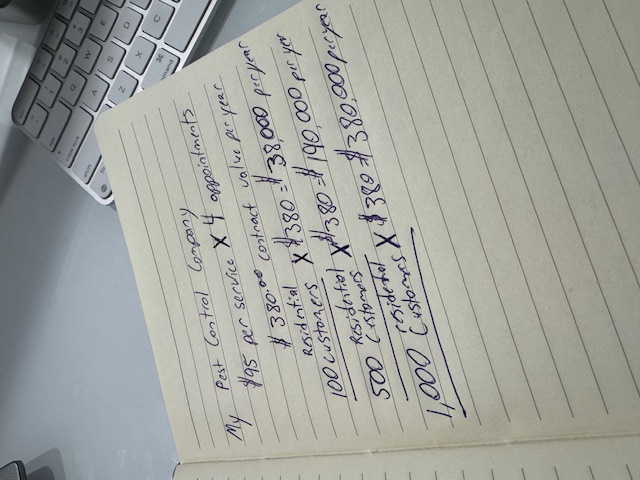Pest Control Business Projections Calculator: Break Even & ROI
This pest control business calculator estimates your potential profitability by analyzing revenue streams, labor costs, and business expenses to generate 5-year financial projections. Use the results to evaluate if the business idea is worth pursuing further.
Input Your Pest Control Business Data
Pest Control Business Name
Revenue Sources
One-Time Service Revenue
Enter your pricing and volume for individual pest control services that are not part of an annual contract.
Seasonal Adjustment
Labor Costs
Business Expenses
| Expense Description | Amount | Type | Actions |
|---|---|---|---|
Chemical/Supply Costs (Residential) | $15 | Per Residential Job | |
Chemical/Supply Costs (Commercial) | $50 | Per Commercial Job | |
Vehicle Costs | $500 | Monthly | |
Equipment Costs | $2,000 | Yearly | |
Marketing Costs | $1,000 | Monthly | |
Overhead Costs | $2,500 | Monthly | |
Licensing & Certification | $1,500 | Yearly | |
| Total Fixed Monthly Expenses | $4,292 | ||
Click on any row to edit expenses or
Business Assumptions
How to Use the Pest Control Business Calculator
I built this pest control business calculator to help entrepreneurs evaluate the profit potential of entering the pest control industry. According to IBIS World, the average profit margin for pest control businesses is 13.3%. This calculator will help you project your revenue, expenses, and profitability over a 5-year period to see how your business idea compares to industry benchmarks.
The typical pest control business in the U.S. generates approximately $401,900 in annual revenue according to SharpSheets, with many operators increasing profits by offering both one-time services and annual service contracts.
After using this calculator, you can download a sample projection to include in your business plan: Sample Pest Control Financial Projections.
Pest Control Business Industry Overview
The pest control industry serves residential and commercial property owners who need to eliminate or prevent pest infestations. Services typically include treatments for insects, rodents, termites, and other unwanted pests. The industry has proven resilient through economic downturns as pest control is often viewed as a necessity rather than a luxury.
Nate Jones, entrepreneur and owner of Wexford Insurance, explains the broad market opportunity: "Pest Control there's a massive need for it because people don't know how to get rid of their pests. Ants, bees, wasps, termites, rodents, ticks, fleas, mosquitoes, bed bugs." This creates year-round revenue opportunities regardless of your location in the United States.
Starting a pest control business requires proper licensing and certification, which varies by state. According to David Bailey from FieldRoutes, initial investments typically range from $20,000 to $50,000, covering equipment, chemicals, vehicles, insurance, and initial marketing. The business model can scale effectively by adding technicians and expanding service territories.

Pricing varies significantly based on property size, pest type, and location, but residential services typically range from $100-$300 per visit, while commercial services can range from $500-$1,500 per treatment. Annual contracts, which often include quarterly treatments, provide more stable recurring revenue and are a key component of successful pest control businesses.
My Experience as a Pest Control Customer
I have an annual contract with a local pest control company that services my home. They visit quarterly (four times per year) at $95 per visit, making me a $380 annual client. I've been with them for over four years, which demonstrates the recurring revenue potential of this business model.
I've noticed a clear difference since enrolling. In summer, wasp nests that form near my fence or gutters disappear after service visits with dead wasps visible around my property perimeter days later. The service also helps keep rodents away during winter months, although I've considered canceling during colder periods when insect activity is minimal.
This personal experience helped me understand both the value proposition from a customer perspective and the business model's economics. Based on my annual spend, I ran some basic numbers:

One challenge I immediately recognized is the volume of customers needed to build a sustainable business:
- 100 customers at $380 per year = $38,000 in annual revenue
- 500 customers at $380 per year = $190,000 in annual revenue
- 1,000 customers at $380 per year = $380,000 in annual revenue
With the industry's average 13.3% profit margin, even 1,000 customers would generate only about $50,540 in profit before taxes. Of course, owner-operators who perform services themselves can significantly improve these margins, but the customer acquisition challenge remains critical to address in your business planning.
Step-by-Step Guide to Using the Calculator
Step 1: Enter Your Business Information
Start by entering your pest control business name. This is just for labeling your projections and can be changed at any time.
Step 2: Input Revenue Details
Enter your pricing and volume for both residential and commercial services:
- Average service price for residential and commercial jobs.
- Monthly job counts for each service type.
- Seasonal adjustment factors to account for busy and slow periods.
- Customer retention rate to project recurring business.
Step 3: Add Contract Revenue (Optional)
If you plan to offer annual service contracts (recommended for business stability), enter:
- Number of residential and commercial contracts
- Average annual value of each contract type
- Contract renewal rate
Step 4: Enter Labor Costs
Input your labor costs including:
- Number of technicians
- Hourly wage
- Average time spent on residential and commercial jobs
Step 5: Add Business Expenses
Enter your regular business expenses such as:
- Chemical and supply costs (per job or monthly)
- Vehicle costs (fuel, maintenance, insurance)
- Equipment costs (sprayers, protective gear, etc.)
- Marketing expenses
- Office and overhead costs
- Licensing and certification fees
You can add or remove expense categories to match your specific business model.
Step 6: Set Business Assumptions
Enter key business assumptions:
- Annual growth rate (typically 5-10% for established pest control businesses)
- Target profit margin
- Estimated tax rate
- Initial startup costs
Step 7: Calculate and Analyze Results
Click "Calculate Pest Control Projections" to generate detailed financial projections across four tabs:
- Summary: High-level metrics including total revenue, expenses, profit, and industry comparisons.
- Break-Even: Analysis of how long it will take to recover your initial investment.
- Annual Chart: 5-year projections showing revenue, expenses, profit, and profit margin trends.
- Revenue Breakdown: Visualization of revenue distribution across service types.
Expert Insights: Building a Successful Pest Control Business
I reached out to several pest control business owners to gather insights on what makes a successful small business. Their advice helped inform the calculator's inputs, but I suggest paying attention to their sales and marketing advice to help build your customer base.
Balance Residential and Commercial Accounts
Arlington Nunez, owner of Aviator Pest Control in Houston, TX, emphasized the importance of maintaining a mix of both account types: "Don't always start chasing commercial accounts all year long or all day long, make sure you're taking some residential accounts… they actually have helped me get more revenue because they'll refer me to their neighbors… 'Hey, I work for this company, I mention you to them, you should come do a pest control service for us.'"
This synergy between residential and commercial clients can create a powerful referral engine. The calculator allows you to input both service types to model this balanced approach.
Price Commercial Services Based on Traffic
Nunez also shared a pricing insight for commercial accounts: "He charged [Texas Roadhouse] $500 a month… they make millions a year, $500 is nothing to them, they need pest control because they have so much traffic… if you really want to quote high on a commercial account, you got to study the traffic."
This illustrates how high-traffic businesses like restaurants can support premium pricing, which is reflected in the calculator's commercial service pricing inputs. The pricing opportunity for commercial accounts is often significantly higher than residential services.
Use Strategic Sales Approaches
When approaching potential clients, Nunez recommends a specific question: "When you really want to break the ice and let them know what you want is asking who currently does your pest control. I'm like 'Hey just out of curiosity who does y'all's pest control?' Sometimes they'll say 'Oh we actually don't have anyone.' Or they'll say 'Oh we have this big company like blah blah blah.' If they say it's a big company, oh that's a wrap… I know I can easily pivot."
This strategy helps identify immediate opportunities (properties without service) and competitive opportunities (properties with large, impersonal providers who may be vulnerable to a more personalized approach).
Leverage Annual Contracts for Cash Flow
Eric Bassett, host of the Bug Bux Podcast, suggests using discounted annual contracts as a cash flow strategy during tight times: "If your business is at stake… go knock doors sell accounts if you need cash sell annual contracts up front for and discounted by 50%."
While discounting isn't ideal for long-term profitability, this approach can generate immediate cash flow during startup or emergency situations. The calculator's contract inputs allow you to model different pricing strategies.
Owner Advantage in Sales
Bassett also notes that business owners have a natural sales advantage: "If you own your pest control company, it's a lot easier to make sales. When they see that there's a dude or a lady out there that's hustling for their own company that strikes a different kind of nerve."
This highlights the importance of owner involvement in sales, especially during the startup phase. The perceived authenticity of dealing directly with the owner can significantly improve close rates.
Diversify Service Offerings for Year-Round Revenue
I've observed that some lawn care and landscaping companies offer pest control as an add-on service for existing customers. This presents an opportunity to either expand from landscaping into pest control or vice versa. The calculator allows you to model different service types to evaluate diversification opportunities.
As a customer, I've wondered about the value of winter pest control services when it's too cold for most insects. This presents both a challenge and an opportunity for pest control businesses to educate customers about year-round threats like rodents or overwintering pests, or to offer complementary winter services that maintain revenue during slower seasons.
Pest Control Business Financial Formulas
Here's a breakdown of the core calculations used in this calculator:
| Metric | Formula | Example |
|---|---|---|
| Monthly One-Time Service Revenue | (Residential Price × Monthly Residential Jobs) + (Commercial Price × Monthly Commercial Jobs) | ($95 × 40) + ($350 × 10) = $3,800 + $3,500 = $7,300 |
| Seasonally Adjusted Revenue | Monthly Revenue × Seasonal Adjustment Factor | $7,300 × 1.2 (summer) = $8,760 $7,300 × 0.8 (winter) = $5,840 |
| Monthly Contract Revenue | (Residential Contract Value × Residential Contracts ÷ 12) + (Commercial Contract Value × Commercial Contracts ÷ 12) | ($380 × 100 ÷ 12) + ($1,200 × 20 ÷ 12) = $3,167 + $2,000 = $5,167 |
| Monthly Labor Cost | Technician Hourly Rate × Hours Per Month | $22 × ((0.75 hrs × 40 jobs) + (2 hrs × 10 jobs)) = $22 × (30 + 20) = $1,100 |
| Chemical Cost Per Month | (Chemical Cost Per Residential Job × Monthly Residential Jobs) + (Chemical Cost Per Commercial Job × Monthly Commercial Jobs) | ($10 × 40) + ($30 × 10) = $400 + $300 = $700 |
| Monthly Profit | Total Monthly Revenue - Total Monthly Expenses | $12,467 - $8,800 = $3,667 |
| Profit Margin | (Monthly Profit ÷ Monthly Revenue) × 100% | ($3,667 ÷ $12,467) × 100% = 29.4% |
| Break-Even Point (Months) | Initial Investment ÷ Monthly Profit | $25,000 ÷ $3,667 = 6.8 months |
| Annual Growth Rate | Previous Year Revenue × (1 + Growth Rate %) | $149,604 × (1 + 10%) = $164,564 |
| Customer Retention Impact | Previous Year Contracts × Retention Rate % | 120 contracts × 85% = 102 retained contracts |
I suggest using this calculator as a starting point for your pest control business planning. The pest control industry's combination of recurring revenue, essential service status, and relatively low startup costs makes it an attractive opportunity for entrepreneurs willing to get out there and aggresively market themselves.
But be realistic about the number of customers you'll need to cover business living expenses too. As my earlier example showed, you'll need hundreds of residential customer minimum to make the numbers work out on this business.
